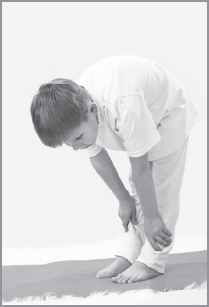
Forward Fold (Uttanasana) Pose
A simple Vinyasa warm up sequence can assist a parent, teacher or therapist when providing a yoga intervention for children. A yoga intervention is a hatha or restorative yoga pose, movement series, breathing exercise or guided imagery that offers a break or empowers the students and caregiver to meet their goals. These brain body tools facilitate the child to energize, focus, regulate emotionally and calm. These activities can take as little as 2 minutes or up to 15 minutes depending on the time allotted.
Sitting in a chair, begin to breathe in the three-part breath (See Chapter 5). Reaching both arms overhead take an inhale. Exhale as you move the arms down again. Repeat this five times.
Seated Cat and Cow: Placing your hands interlaced behind your head, do the Cat pose. Folding elbows forward, head slightly down and condense as you bring the elbows together in the front of the face with an exhale. Then open the folded arms, bringing the arms back along the shoulders with a slight arch back while inhaling. Repeat 5 sets
Side bends: Inhale and raise the left arm. Lean to the right, extending the arm overhead and to the right. Exhale and bring the arm back to the center. Repeat with the right arm over the head, bending to the left side and then back to center.
Seated twist: Find a comfortable seated posture facing forward. Turning to the right, bring the right arm behind you and hold the chair back. Continue rotating with the left hand twisting the torso and place the left hand on the outside of the right leg.
Toddlers can imitate simple movements. Adults can assist using hands on, and verbal cues. Move slowly through the poses with a gentle voice and pace. Repeat several times or to tolerance. You may wish to offer a gentle touch and handling, to assist the child to get in and out of poses. Face the child or sit behind the child as you face a mirror.
With toddlers, the therapist or caregiver needs to hold the child for support and may need to assist the child into the pose depending on age. Therapists can start working with a young child using yoga as early as infancy offering the opportunity to move through developmental patterns. Child’s pose has the underpinnings of an early basic neuro-cellular pattern (a principle of Body Mind Centering) called a spinal pattern; the Downward Dog offers a chance for the therapist to assist the child to do upper body weight bearing and has the underpinnings of a push pattern. Facilitating Upward Dog develops the child’s back and neck muscles. Other poses that can be facilitated are:
• Forward bend
• Tree
• Downward Facing Dog
• Upward Dog
• Three-legged Dog
• Bridge
• Cat
• Cow
• Child’s pose
• Sponge pose
• Begin in Cobbler Pose.
• Crossing one leg over the other, stacking the knees pointed forward, place the calves and ankles on the sides of the thighs and directed back towards the hips and reach up with arms. Assume Cow Face Pose and inhale the arms up and exhale.
• Extending the legs forward straighten out, inhale the arms up and into a forward bend and exhale. Come back up to a seated pose. Inhale as you side-bend to right, weight-bear on right hand and left arm extends over head to right side. Repeat on opposite side.
• Place the left foot on the floor with knee bent and extend the right leg. Inhale as you twist to left and place left hand to floor behind left hip, then turn left and place right hand on the outside of the left knee on the floor or the leg. Exhale in the pose. Repeat on opposite side.
• End with Sponge Pose.

Forward Fold (Uttanasana) Pose
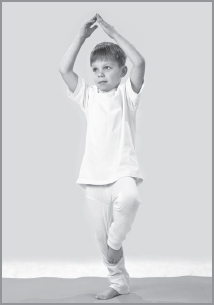
Tree Pose
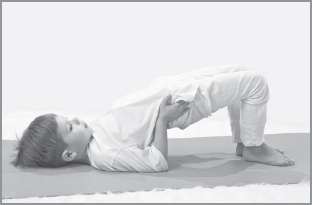
Bridge Pose
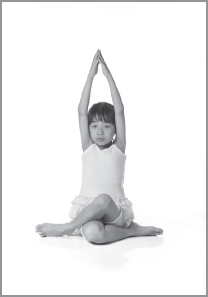
Cow Face
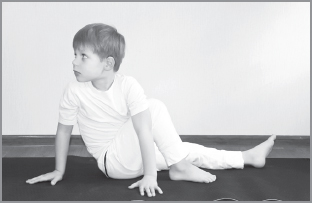
Seated Twist
Sensory Yoga originated from serving populations of students with mixed skill levels in a group. Some students had sensory processing issues and needed extra cueing to be successful with a movement oriented circle time. As a preschool itinerant OT, I would offer to do 10 minutes of circle time. I would combine my experience of using sensory processing activities with yoga. I might add tasks that utilized the tactile system or touch and proprioception or information to the joints and vestibular or movement such as rocking. I coined the term “sensory yoga” when I added these qualities to an activity. Often teachers will welcome a break from the traditional circle time. Without going into a lot of detail with the teachers, I would explain how yoga could be helpful for self-regulation, reducing behaviors and movement skills for the class. I emphasized that breathing can help children’s nervous systems switch from sympathetic to parasympathetic, explaining that this helps the kids become calmer. You can demonstrate this by doing several poses, deep breathing and a relaxation pose such as the Sponge.
• Suggest a “push–in” during preschool or school age circle.
• Explain that yoga is relaxing, includes breathing and reduces behavior issues.
• Note the preventive nature of body based focused activity.
• Promote how yoga can contribute to avoiding anxious behaviors.
• Use a visual image of a pose on a card, iPad, or notebook.
• Demonstrate the pose and ask the children to imitate you.
• Educate teachers with a yoga DVD of music and postures.
• Allow the children to become accustomed to the poses.
• Practice the sequence repeatedly in the same order.
• Embrace each child at their own pace and capability.
• Watch for tolerance and response to the calming ambiance.
• Choose a video, if needed that is calming and appropriate for your group.
• Beware of videos with fast images and distracting animation.
• Choose a temperately animated video.
• Utilize a sensory yoga group as preparation for seated work, before a rest time or as a break in the day between activities.
• Have fun with the results.
• Stay in the present moment, avoid judging the experience.
I have held many sensory yoga groups at preschools and school programs. The groups took place in an integrated classroom with typical and special needs children ages 3-5 years old. This 10-15 minute sequence was tolerated well. If you wish, you can add a longer relaxation in the last 2-3 minutes. Plan a 2-minute re-orientation and transition back to the circle time schedule. Allow for variance, depending on your group.
I always demonstrated the poses myself and had a picture to show the group. I would mix doing some sensory activities in with the poses. If the kids were lying on their stomachs, I might go around the circle and apply deep pressure with the large green ball on each child’s back. Sometimes, one child demonstrated the pose along with me. It was evident that most children loved to do yoga poses that had an animal name. The children stay interested and want to move their bodies.
Walking around the circle, I held up a picture of each pose for the children to see. Keeping my voice quiet and gentle, I engaged the children by asking questions such as: “We are going to do a pose like a dog. Who has seen a dog stretch? Who has a dog at home? What is your dog’s name?” This allowed me to stay engaged with the individual children and monitor who needed some extra attention. We would then do the pose of Downward Dog together. This also would meet some of the teacher’s goals for the group for following directions, focusing and paying attention.
Doing circle time yoga in a group also revealed to the teacher and myself unidentified sensory processing issues or poor motor planning skills in the children. I would make a mental note of who couldn’t follow the directions, wasn’t able to distinguish between a command to lie down on their back or stomach, became overly excited or couldn’t self-calm, I would mention my findings to the teachers and make suggestions for further evaluations if needed.
• Medium size green therapy ball
• Small squishy koosh®
• Vibrating toy (optional)
• Pictures of the poses (on cards, iPad or a notebook)
• Bean bags for eye pillows, wash cloths or paper towel
• DVD if you prefer to not demonstrate
“Today we will be doing some movement, breathing and imitating the shapes of animals with our bodies. Who wants to be an animal? At times we can make noise and other times we have to be very quiet. Before we start, I will be passing around the large green ball. When it is your turn, you can say your name and tap the ball as hard as you wish. After your turn, pass the ball to your friend and then sit very quietly. Show me you are ready by looking up here at me.”
• Lights out or dimmed
• Lay mats or towels out in a circle
• Give children their own safe space
• Begin with a sensory warm up activity
• Breathe deeply (the equal breath teacher counts the beats out loud. Inhale 3, Exhale 3. Repeat 2-3 x)
• Practice poses
• Relax in Do-Nothing-Doll pose
• Sing
• Proprioceptive activity “to tap the ball” helps some children settle down
• Introduce Mountain pose for line-up and for standing still
• Breathing activates the parasympathetic nervous system for calming
• Singing at the end of poses creates deep relaxation
Start in a seated pose. Begin by having the children inhale and raise their arms. If you do a backbend always do a forward bend to follow and balance the body. Always do poses on both sides of the body. We always inhale as we arch, extend up and exhale as we flex, fold in and come down. These poses may be used for school-aged children through adolescents. If this sequence is too long for your client, you may shorten it.
• Pretzel twist
• Belly breathing or equal breath
• Cat and Cow
• Sphinx
• Downward Dog
• Upward Dog
• Tree
• Mountain
• Table
• Bridge
• Butterfly (flutter knees)
• Lion
• Child’s pose
• Sponge pose
• Sing names of the students. Or design a song of calming, inspiring words such as: snowflakes falling silently, sun shines down on me.
• Sponge pose: Lie down on back in the Do-Nothing-Doll pose
• Lie on the back with arms relaxed and palms up, legs spread slightly
• Offer a blanket or sweater during sponge as children may become cold
• Increase the relaxation with bean bags or towels as eye pillows
• Allow the children to rest for several minutes after the poses
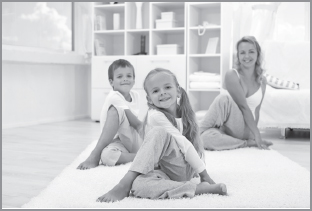
Pretzel Twist Pose
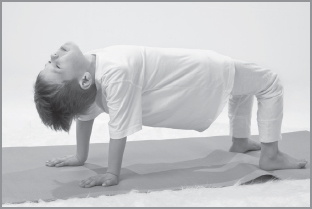
Table Pose
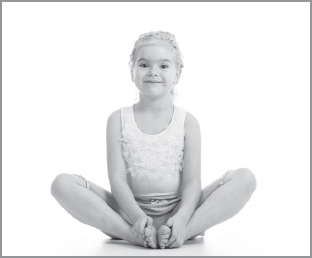
Butterfly (flutter knees) Pose
• Choose to allow the child to just be
• Give deep pressure or breathe by sitting back to back
• Have the child sit near you
• Create helper jobs for that child:
º Lay out the mats
º Roll the koosh ball under the students during Bridge, and Table
º Hold up the pictures of the poses
º Pass out the eye pads (bean bags or folded wash cloth, paper towel)
º Identify if anyone is cold during Sponge pose/ Do-Nothing-Doll
º Pass out blankets, towels or jackets during relaxation
º Collect eye pads and blankets
• Lower the lights
• Encourage everyone to lie down in Sponge pose
• Watch a yoga DVD and allow the children to watch or do the poses
• Accept what level of participation is possible
• Avoid demanding participation or punishing
• Pick very simple poses: Cat, Cow and Sponge pose
• Add sensory stimuli (Thera-Band® pull, vibration, straw-blowing tasks)
• Make the session shorter
• Permit low expectations
• Be happy with the results
• Practice non-judgment and acceptance with yourself and the students
• Praise the kids’ involvement at what level they can do
• Read a story while the children lie in Sponge pose
• Patiently keep trying: Exposure to the calm ambiance is cumulative
• Instruct the children when Sponge is over to sit up slowly
• Script: “It is time to come back to the circle. We are coming to the end of our yoga session. Please sit up in a comfortable posture. We will sing . . .”
• Prepare children to end circle, with legs crossed
• Give the children the directions to “inhale.”
• Give directions to: “Exhale while saying a word that is inspiring”: courage, love, friendship etc. as a group in a singing fashion or the children can also say their name
• Time is given for the transition, ending 5 minutes before the hour
• The children are asked to sit up quietly and listen for the next instructions
• The children sing out their names
• The instructor thanks the children for participating and putting mats away
• The children place their hand together palms touching near their hearts
• Inhale and end with exhaling out the sound O as in “open.”
• In a singing fashion sing out, “open our hearts “as they open their arms to the sides then squeeze the hand of the child near them. This can end the session or everyone together can take a bow together and say, “I bow to the light within you and me” or repeat “peace” three times as the closing ritual
• Children roll up mats and put away
• Place the hands in a mudra touching thumb and first finger together
• Exhale the O sound
• Place hands on lap, the children bow to one another silently
• The children can repeat, “I bow to the light within you and me” silently or out loud and make eye contact with the group. Or, the teacher can say this for the group. Repeat the word “peace” 3 times to close.
• Children put the mats away.
Yoga can be used as a treatment modality and enhancer to meet many goals within a hospital, clinic or school setting. Adaptive yoga is a process by which we might alter a pose to the capability of the clients, with props or assistance. Whether we are trying to bend forward to pull socks up and choose to practice a seated version of forward bend, gain balance with Tree pose against a wall, or reduce anxiety with a hand mudra, yoga can be applied at any age to assist in learning daily living skills.
As an OT in the schools, I often suggested Mountain pose to teachers for children with sensory processing issues and with poor line-up skills. Teachers would often use it for the entire class.
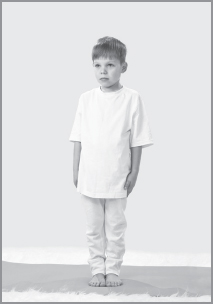
Mountain Pose
• Ask the children to come to stand.
• Invoke the image of a mountain: still, strong, even and steady.
• Have the children stand in a natural pose, placing their arms at their sides, and feel their feet melt into the earth while standing straight.
• Imagine a grounding pole going from their feet down to the center of the earth holding them still and steady.
In a school for autistic and profoundly handicapped children, a physical therapist was successful having a session using the following protocol:
• Secure a quiet space familiar to the student. (In this case, all the other students left the classroom for another activity, and the therapist worked at the circle time rug near where the student sat, so as not to disturb him.)
• Play quiet music (can use Pandora® Radio on the iPad®).
• Use a gentle soft voice and touch to communicate your presence.
• Use the same set routine of postures.
• Start with a seated pose on the floor, legs extended.
• The therapist sits facing the student with legs extended also.
• Therapist places her legs on the outside of the child’s legs.
• Bending at the waist, the therapist pulls the student’s arms gently creating a gentle rocking motion backward and forward.
• Facilitate the following sequence of poses for the child:
º Happy Puppy (quadruped and rock hips laterally)
º Cat and Cow
º Child’s pose
º Tree pose with assistance
º Happy baby
• Conclude with guided imagery meditation
Patty is a bright teen who has cerebral palsy. She wears a scoliosis jacket, is tube fed, is non-verbal and uses an eye gaze-driven computer to communicate. One day, during my session, she was very uncomfortable and couldn’t settle down. She was rejecting her fluid through the tube, and so we tried breathing together. She also liked it when I talked to her about anatomy, and put her hand on my bones and then placed her hand on her bones. We tapped the sternum and I asked her to focus on the front of the spine and the digestive tract. I took her hand and put it on my belly so she could feel me breathing. Then I put her hand on her own belly. Slowly she was able to lengthen her breath, relax, and accept the fluids.
The Attunement Lifestyle Profile (a self-processing tool) is an integrative or holistic group of questions to assist families or clients in assessing what might be needed to arrive at a healthy lifestyle in mind, body and spirit. The Profile can be helpful for any family and for those coping with the stress of raising a child who has trauma, sensory processing issues, autism or any special needs or just the typical stress of raising children. The profile is designed so that families can assess what strengths they have already, or have the potential for, and what areas need strengthening. The profile also offers in the questions some yogic and mindfulness principles that parents might not have realized could help them to reduce stress. Examples such as eating a meal together to encourage communication, taking time for silence and contemplation and everyone taking a break from electronics in the name of family time, can be vitally helpful for quality of life.
Lucy is a 12-year-old girl who lost the use of both her legs. She uses a Hoyer lift for transitions, a motorized chair, and has good cognitive and verbal language skills. Lucy had spent the first 8 years of her life as neuro-typical and had an unfortunate situation that led to her disabled state. She could easily make her needs known and had conversations that a typical 12-year-old would have, although her articulation was slurred. At times it was difficult for others to understand what she wanted which was frustrating for her. She had one functional upper extremity, but the other affected arm didn’t function as a consistent stabilizer. Lucy was more mature than her age due to her unusual transition to disability. She was observed helping other children in the house reach for things with her functional extremity and she clearly enjoyed that role.
During her occupational therapy intake for her group home, after covering the basic OT assessment areas, we discussed the profile with a staff member present. We looked together at the PowerPoint version of the Attunement Profile adapting it to the community and family milieu of the group home setting. The profile is available through a certification course and ebook: The Attunement Lifestyle Profile: Cultivating Balance taught by the author.
Lucy was able to see the pictures that accompany the questions. She looked carefully at each slide and took in the emotionality of the visuals. She was very interested in the visual slides and questions such as, “do you have family meetings?” “do you go on educational outings?” and, “do you have friends to laugh with?”
The house assistant supervisor and I gleaned many of Lucy’s important feelings from the use of the profile. The conversation that ensued allowed us to problem solve in the moment. We identified possible options to enhance quality of life that the program already had in place but hadn’t yet considered for Lucy. The profile shed light on Lucy’s feelings at this time, and illuminated the subtleties of her lifestyle preferences. It was a true game changer and empowered Lucy and encouraged the staff to deliver quality services that were already available but not yet implemented for her.
• Maintain a sense of humor.
• Teach what you know.
• Keep the activity simple.
• Be compassionate with yourself and others.
• Strive to be even-keeled.
• Avoid punishing or getting angry during yoga.
• Go with the flow.
• Adapt to kids’ tolerance.
• Remember less is more.
• Avoid rushing to get somewhere.
• Emphasize sensing, breathing, being, feeling, embodying.
• Create a safe space.
• Remember to breathe yourself.
• Focus on relaxation and acceptance.
When doing yoga with students, remember your own state of mind is the most important gift and the vehicle to a successful session or class for others. Being open, having fun and keeping things light is half the challenge. It is less about getting somewhere, and more about being where you are in each moment. If you need to calm yourself, take a few extra moments in the beginning with the client or class and together practice deep breathing. Get eye contact from the students, and be gentle in any handling techniques. One student I work with will only tolerate three repetitions of one moving warm-up pose. For him, that is an accomplishment, and I am happy with the response. When I practice contentment with the results no matter how small they are, the practice flows more easily.